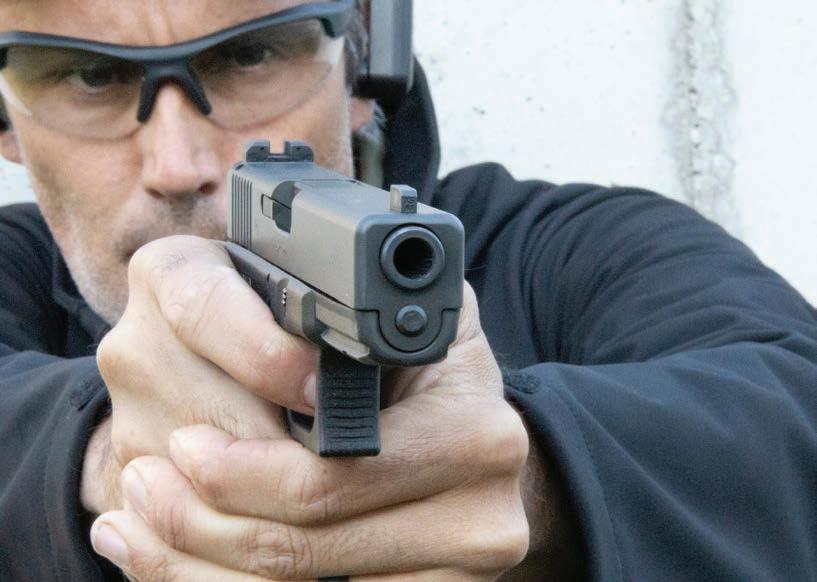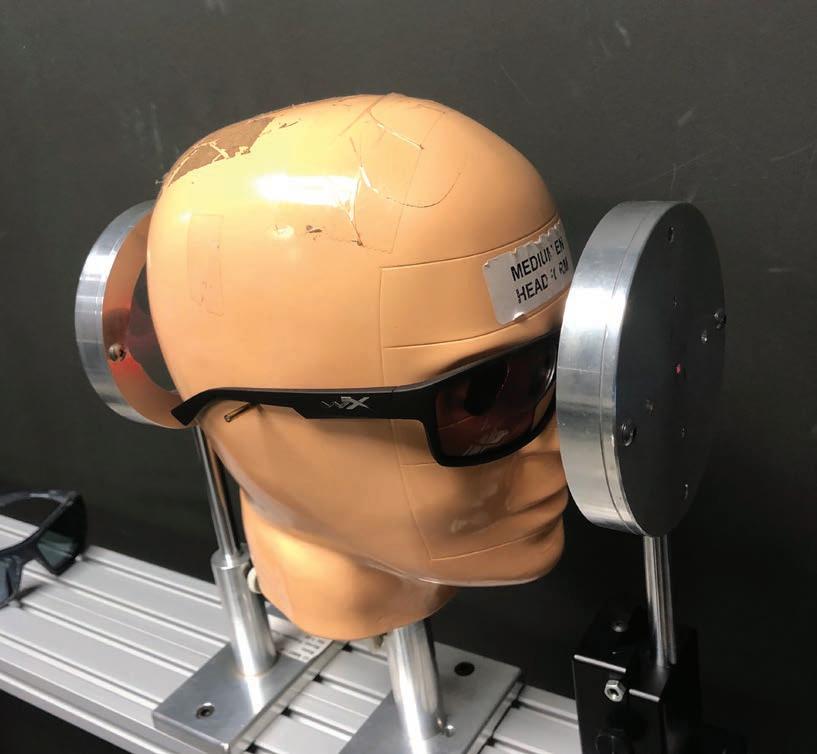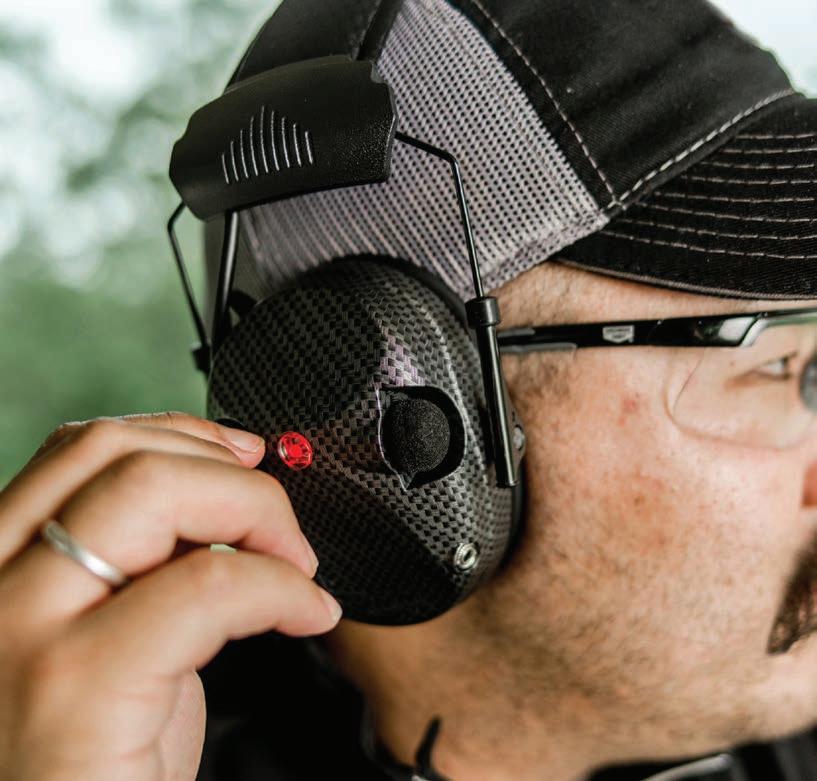
5 minute read
EYES AND EARS
New shooters need to know how to protect their eyes and ears at the range.
by Brad Fitzpatrick
New gun owners have a great deal to learn before their first trip to the shooting range. Understanding the basic operation of the firearm is critically important, and matching ammunition to firearm can be a real challenge for someone who doesn’t know the difference between 9mm Luger and 9mm Luger +P ammunition or understand a .357 Magnum revolver can fire .38 Special ammunition, but a .38 Special can’t fire .357 Magnum ammo. Yet, one of the basic tenets of safe firearms handling—wearing hearing and eye protection—should be simple and straightforward even to those who’ve never owned a firearm.
But there’s a catch: not all hearing and eye protection is created equal. The earplugs used to deaden the sound of hard-partying neighbors in a hotel most likely won’t provide adequate protection against the sound of gunshots, and wraparound sunglasses suitable for a day at the beach won’t be durable enough to stop an errant pellet at the shotgun range.
So, how do new shooters know what to look for? In most cases, they don’t. Here is where you and staff can help by using the simple guide below to be certain that a customer’s gear is up to the task.
EYE PROTECTION: ANSI RATINGS
The American National Standards Institute is a nonprofit organization founded in 1918 to “administer and coordinate the U.S. voluntary standards and conformity assessment system.” ANSI doesn’t develop the standards for eyewear protection, but the ANSI rating of eyewear can help determine whether glasses are suitable for shooting.
ANSI testing involves, among other things, highmass impact and high-velocity impact testing. Safety glasses that are ANSI Z87.1 rated have been proven to withstand the impact of a one-inch steel ball dropped onto the lenses from 50 inches. ANSI Z87+ ratings mean that the glasses have passed the standard impact test plus additional tests that require the lenses to withstand high-velocity impact from smaller projectiles as well as other more rigorous tests.
For most shooting glasses, Z87.1 or Z87+ (sometimes written Z87.1+) is standard. However, there are also glasses that are designed to meet even more stringent military standards. Known as MIL-PRF 32432 (or ballistic fragmentation test), these glasses are subjected to impacts from a .15-inch projectile fired into the lenses at a speed of 640 feet per second; only if the lenses can withstand this impact are they MILSPEC certified. Oddly enough, even though MILSPEC standards require lenses to withstand impacts that are roughly seven times higher than the standards for ANSI Z87.1, there are some glasses that are MILSPEC rated, but don’t meet ANSI Z87.1 standards. Gatorz Eyewear Delta lenses are one example: Gatorz Delta lenses exceed MILSPEC ballistic fragmentation standards, but because of their partially open lens design (i.e., the lenses are not fully enclosed by the frame) they don’t meet ANSI standards.

It’s important to be certain that the shooting glasses a customer selects meet ANSI and/or MILSPEC standards. Shooting glasses from most major eyewear brands like Leupold, Gatorz, Venture Gear, and Wiley-X will list their rating so there should be no problem identifying suitable products. These are all better options than standard non-rated sunglasses that may fail to protect the eyes in the event of an accident.
Hearing Protection And Decibel Reduction
Decibels are the unit of measure for sounds, with zero dB considered absolute silence while a 1 dB is barely audible. The term decibel actually refers to a tenth of a Bel, the unit of acoustic measure named after Alexander Graham Bell. Decibels are used to measure sound in place of bels because, in most cases, a sound change of one decibel is the smallest change in volume that the human ear can detect. An increase of just three decibels doubles sound energy, but to the human ear sound “doubles” roughly every ten decibels based on perception. Because decibel levels increase on a logarithmic scale, a 60 dB sound (average human speech) is not 60 times louder than a 1 dB sound, but rather 106 (1,000,000) times louder.

The human sense of hearing is remarkably complex. We hear sounds because sound waves travel through the ear canal and vibrate bones that amplify the noise and send it to our cochlea (inner ear).
Fragile hairs inside the cochlea vibrate based on the sound frequency, but these hairs are susceptible to damage. Loud noises can cause hearing loss, and the rate and severity of that loss is a combination of the sound’s intensity in decibels and exposure time.
Noises of 85 dB (equivalent to a noisy restaurant) or more can cause hearing damage after long hours of exposure. Higher dB sounds like loud rock concerts or fireworks (both of which can be in the 130 to 140 dB range) are instantly painful and damaging to the hearing.
Centerfire rifles, handguns, and shotguns are all capable of producing sounds in the 150 dB range, which is instantly painful and damaging. Even rimfire guns like the .22 Long Rifle produce dB levels of 140 or more. For this reason, it’s important to always wear hearing protection while shooting a firearm. But which form of hearing protection should a customer wear?
Soft foam earplugs are a common choice, and they do reduce dB and deaden sound. Foam earplugs are cheap, easy to use, and widely available, but they only reduce the sound by about 15 to 30 decibels if worn properly. Protective muffs typically drop sound levels by about the same 15 to 30 dB. In many cases that’s enough reduction to reduce pain levels, but in the case of centerfire rifles (especially those with muzzle brakes) it’s not always enough to protect against hearing loss, so sometimes you’ll need to double up with muffs and earplugs if the sound is exceptionally loud. On rare occasions even that won’t drop noise to comfortable levels. I recall shooting a magnum centerfire rifle with a brake underneath a metal overhang and found the noise to be unbearable, even when doubling up earplugs and muffs.
In most instances, such as shooting shotguns at the clay range or target shooting with a centerfire pistol, a high-quality pair of plugs or muffs are sufficient to bring gunshots down to hearing safe levels. There is a new trend toward electronic hearing protection (either in the form of muffs or earplugs) to amplify safe sounds but block dangerous ones so you won’t have to scream to communicate with other shooters but dangerously loud gunshot soundwaves are still blocked. One company—Tetra Hearing—has developed noise-canceling earplugs that amplifies certain frequencies of sounds that hunters want to hear, like turkey gobbles. This is a very clever add-on.
The downside to electronic hearing protection, of course, is higher cost.
Regardless of which design is chosen, it’s important to have effective hearing protection at the range. Hearing loss is a slow, progressive condition that, once recognized, cannot be reversed, so it must be avoided.

Remind the customer that humans only have one set of eyes and ears. And medical science hasn’t advanced far enough to create viable replacement parts. An investment in quality eye and ear protection not only enhances the shooting experience, but helps ensure they will stay safe on the range and in the field.
Faq
How do I keep my shooting glasses from fogging up?
There are two options to prevent your lenses from fogging. First, you can increase airflow around the lenses, which reduces the temperature and allows moisture generated by the body to escape. Second, you can use anti-fog wipes or sprays, which are simple to apply.
What color lenses should I get on my shooting glasses?
Traditionally, shooters chose glasses with yellow or orange lenses because they block blue light and make the orange color of targets stand out in contrast (amber lenses do the same thing). Purple or blue lenses improve contrast in areas with lots of green foliage. Gray is a great color choice for lenses because it reduces light fatigue and maintains a consistent color balance.
Are custom hearing protection products worth the money?
You can certainly get by with standard muffs and earplugs, but custom-molded ear-hearing protection (which is designed to fit your specific ear canal) does have advantages that include increased comfort and greater sound reduction. Custom earplugs are more expensive, though.










